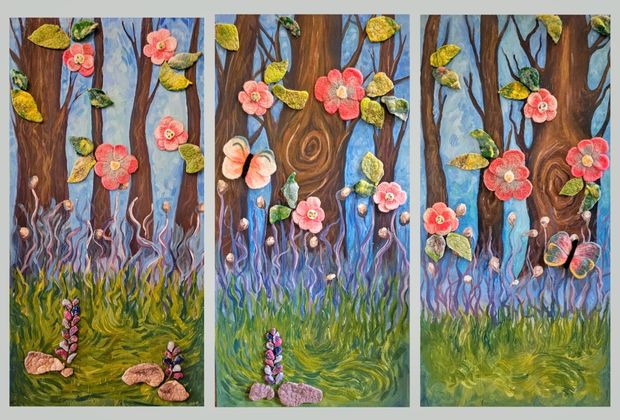Envisioning a Therapeutic Career Path Through Fieldwork

Art therapy major Paloma Collins (BA ’24) had never worked with elderly adults before, so she didn’t know what to expect when she started fieldwork as part of her capstone studies with residents of the older adult community at Wesley Enhanced Living at Stapeley in Philadelphia.
“I learned to ask a lot of questions,” reflected Collins, who was instrumental in helping residents design and craft a four-foot by eight-foot sensory mural on the memory care floor in a hallway where residents pass by to get to their apartments or seek out activities. She described the project as “born of conversations,” spending time getting to know about the residents, their lives and capabilities, and what gave them feelings of calm, comfort and security.
The sensory mural consists of three panels that are roughly four-feet tall and two-feet wide, and depicts a vibrant nature scene of stout trees, leaves, flowers and budding plants, blue sky and swirling grass, and butterflies using colorful felted materials, applying techniques that Collins learned in her studio classes.
It adorns “a wall that is at a turn in the hallway that was not very inviting and made some residents uneasy when confronted with walking around the corner,” said Amy van Brug, MT-BC, MMT, CMDCP, Wesley’s Director of Therapeutic Recreation and a frequent collaborator with Tyler’s Art Therapy program in providing opportunities for students to be get field experience.
Van Brug, a music therapist by training, said that often there are “very limited opportunities for our elders to engage in high quality arts-based programming,” particularly in long-term care settings where restrictive budgets, staffing challenges and tepid support for creative arts therapies exist.
“We still have a way to go but we are proud to use the creative arts as a way of creating community at Stapeley,” she said, adding that the artwork celebrates residents’ lived experience, interests and identities while bringing joy and beauty to them, their families and care partners alike. “Paloma’s process was really amazing to watch as we were able to use the resources in our community to accomplish all three of these aspects,” van Brug added.
“The memory care floor, known as Bridges, often gets a negative reputation. There can be stereotypes and assumptions regarding the residents’ care needs and cognitive impairment in aging that can distort how this area of our community is perceived. The memory care floor also offers a unique learning experience for students to explore how the arts can be a vital tool for engagement for people who interact with the world in different ways than some may be used to. This can be a huge place of learning for students to explore new ways of presenting experiences to support successful engagement for all participants.”
Collins credited her fibers coursework with giving her the idea to teach residents wet felting, which uses water to mat the wool, and needle felting, a dry process that involves a specialized tool, to construct the flat and three-dimensional elements of the mural. She had two advantages: understanding how therapeutic felting can be through her own studio classes and access to loads of material, both at the facility and through a staff person who also worked at a fabric store.
“I really enjoyed the collaboration portion and the groups, being able to facilitate discussions and highlight their experiences and preferences in an art piece. I had not done artwork in that way, and I really wanted to prioritize their vision,” said Collins, who has taught arts classes for youth for some time.
Michaela Herr, MA, ATR-BC, LPC, an Assistant Professor of Instruction in Art Therapy at Tyler, said the sensory mural was a “great visual representation of what fieldwork can look like and what a project can look like. Students are bringing in what they know from what they have learned the past for four years.”
Herr added that fibers art made sense for older people, particularly those with memory loss, because it has been proven to enhance the senses, increase mindfulness and staying in the moment. “It’s helpful for memory just like squeezing a stress ball or petting a cat orients a person to time and space,” she explained. “It’s using the hands and tactile.”
While Collins, under the supervision of van Brug, had the opportunity to experience how art therapy can unfold in a particular setting, she would need to pursue a master’s degree to be board-certified and a licensed practitioner. Still, the field placement provided training in how clinical practice is done.
And beyond the therapeutic benefits of the work Collins did with residents, said Herr, “they have a sense of accomplishment and pride when they walk down the hallway.”